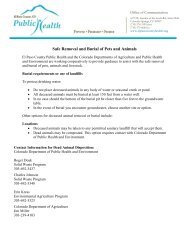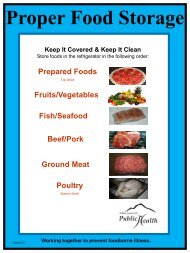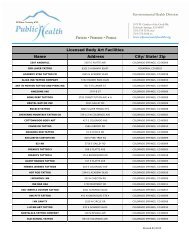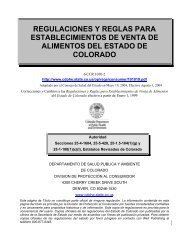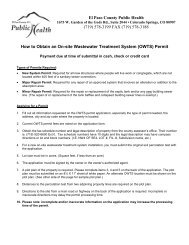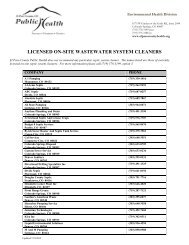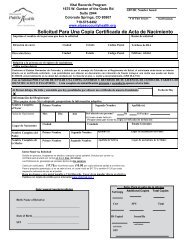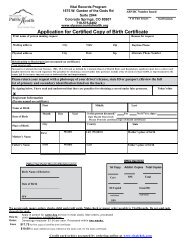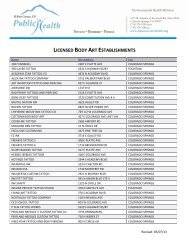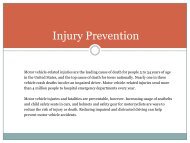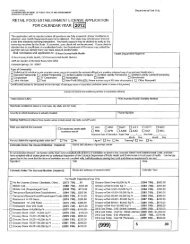Glossary of Terms - El Paso County Public Health
Glossary of Terms - El Paso County Public Health
Glossary of Terms - El Paso County Public Health
Create successful ePaper yourself
Turn your PDF publications into a flip-book with our unique Google optimized e-Paper software.
<strong>Glossary</strong> <strong>of</strong> <strong>Terms</strong><br />
Age-adjusted Rate<br />
Rate <strong>of</strong> a disease or health condition for a given population that has been standardized to control for<br />
the influence different age groups might have on health-related events when comparing populations.<br />
Age-adjusted rates are commonly used when comparing death data between two populations.<br />
Age-specific Rate<br />
Rate <strong>of</strong> a disease or health condition for a particular age group within a given population. Teen<br />
fertility rates are one example.<br />
Birth Rate<br />
The number <strong>of</strong> live births to females <strong>of</strong> a specific age group per 1,000 females in the specified age<br />
group. Also referred to as a fertility rate.<br />
Census Tract<br />
A small, relatively permanent statistical subdivision <strong>of</strong> a county created for the purpose <strong>of</strong><br />
presenting data. Census tracts are designated by the United States Census Bureau and intended to<br />
be homogeneous with respect to population characteristics, economic status, and living conditions.<br />
Census tracts usually have between 2,500 and 8,000 persons and do not cross county boundaries. The<br />
spatial size <strong>of</strong> census tracts varies widely depending on the density <strong>of</strong> a particular settlement.<br />
<strong>Health</strong>y People 2020<br />
<strong>Health</strong> goals defined at the national level by the Department <strong>of</strong> <strong>Health</strong> and Human Services,<br />
which communicate a vision for improving health and achieving health equity with a set <strong>of</strong> specific<br />
measurable objectives; these objectives are defined as targets to be achieved by the year 2020.<br />
Incidence<br />
Measures the occurrence <strong>of</strong> new cases <strong>of</strong> a disease, health condition, or health-related event that<br />
occurs within a specified population over a period <strong>of</strong> time (commonly based on an annual basis). For<br />
example, the number <strong>of</strong> Colorado children newly diagnosed with asthma during 2011. Incidence is<br />
commonly reported as a rate <strong>of</strong> disease or condition per 100,000 population.<br />
Margin <strong>of</strong> Error/Error Bars (See Methodology)<br />
When measurements are calculated from a sample <strong>of</strong> people within a population, these values are<br />
subject to a level <strong>of</strong> uncertainty or error. This uncertainty can be represented through the use <strong>of</strong><br />
a margin <strong>of</strong> error, which indicates a range <strong>of</strong> values for which there is a 95 percent probability <strong>of</strong><br />
containing the true value for the entire population. Error Bars are included on some Figures in the<br />
report and these represent the (95%) upper and lower limits <strong>of</strong> the margin <strong>of</strong> error.<br />
Morbidity<br />
A general term used to describe the occurrence <strong>of</strong> disease or health conditions. Morbidity does not<br />
include death.<br />
Mortality<br />
A term used to describe the occurrence <strong>of</strong> death.<br />
<strong>El</strong> <strong>Paso</strong> <strong>County</strong> <strong>Health</strong> Indicators 2012 Report<br />
Page 51
Poverty Threshold<br />
Income thresholds developed by the United States Census Bureau that incorporate the size and<br />
composition <strong>of</strong> a family to determine who is in poverty. If a family’s income is less than the family’s<br />
poverty threshold, then that family and each individual member is considered to be in poverty. These<br />
thresholds are updated annually to account for inflation. The Census Bureau’s poverty thresholds are<br />
calculated differently than the poverty guidelines issued by the Department <strong>of</strong> <strong>Health</strong> and Human<br />
Services to determine eligibility for public assistance.<br />
Prevalence<br />
Measures the presence <strong>of</strong> existing cases <strong>of</strong> a disease, health condition, or other attribute within a<br />
population at a specific point in time. For example, the proportion <strong>of</strong> Colorado adults who were<br />
current smokers in 2011.<br />
Proportion<br />
The ratio <strong>of</strong> a part to the whole, commonly expressed as a percent.<br />
Rate<br />
A measure <strong>of</strong> frequency <strong>of</strong>ten used to describe how <strong>of</strong>ten a disease, health condition, or health-related<br />
event is occurring in a population. Fertility rates, incidence rates, and mortality rates are common<br />
examples.<br />
Years <strong>of</strong> Potential Life Lost (YPLL)<br />
A measure <strong>of</strong> premature death which describes the number <strong>of</strong> years that an individual was expected to<br />
live beyond his or her death. A cause <strong>of</strong> death that is more common among children and young adults<br />
(e.g., accidents) will result in more YPLL than would a chronic disease more common among elderly<br />
persons.<br />
<strong>El</strong> <strong>Paso</strong> <strong>County</strong> <strong>Health</strong> Indicators 2012 Report<br />
Page 52



